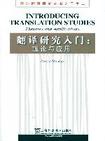翻译研究入门
出版时间:2010-5 出版社:上海外语教育出版社 作者:杰里米·蒙代(Jeremy Munday) 页数:222
Tag标签:无
前言
上海外语教育出版社从成立以来一直是我国外语教育最优秀的后勤部和侦调部。因为它不但为我国各个层次(尤其本科与研究生层次)的外语教育提供了多种高水平的教材、教参和工具书,而且还出版了多学科、多语种和多系列的中文版和外文版的学术著作,比如“现代语言学丛书”、“牛津应用语言学丛书”、“美国文学史论译丛”、“外国文学史丛书”、“剑桥文学指南丛书”、“当代英语语言学丛书”以及列入国家及教育部规划的人文社科重点项目的外国语言文学、文化等方面的图书等。为了适应我国现代化建设和教育改革的需要,还出版了一批国际金融、对外贸易、涉外保险、国际经济法、国际新闻和管理科学等方面的教材与专著。这些著作在外语的学科建设与学术研究以及复合型人才培养等方面都在发挥着强有力的侦察、调研和指导作用。这是外语界有口皆碑的。 随着中外文化交流的纵深发展以及我国现代化建设对人才的需求,对比语言学和翻译学近些年来在我国有了较快的发展,最突出的证据就是①外语类硕士博士点上研究对比与翻译方向的学生在逐年迅速增多,而且我们的高校已经有了翻译学院和翻译系(当然还太少)。②外语专业的学生考中文、法律等其他人文社科专业的硕士、博士以及反方向的走向已经起步。这种跨学科的人才已成为人才资源竞争的最主要对象,因此发展趋势定会看好。上海外语教育出版社为适应这种高层次人才培养和新学科建设的需要,不但积极出版国内关于对比研究和翻译研究的专著和论文集,最近又推出了原版“国外翻译研究丛书”,这套丛书时间跨度丛古代到现代,所选书目皆为译学发展史上有里程碑作用的名家名著,堪称译学经典。他们计划分批出版,以满足读者的需求。
内容概要
《翻译研究入门:理论与应用》系统介绍了古罗马以来的翻译理论流派与思潮,精心绘制了一幅西方译学研究的进程图,全面展现了本领域最新的学术成果及研究动向。与同类著述相比,《翻译研究入门——理论与应用》具有如下鲜明的特点和独特的价值:强调理论之间的内在联系,体现翻译学的系统性;注重理论与实际相结合,突出翻译学的实证性;鼓励进行独立思考与研究,追求翻译学的创新性,等等。 作为翻译学的入门教程,《翻译研究入门——理论与应用》以通俗易懂的语言对西方翻译学的产生、发展和壮大进行了梳理,为学生、教师、研究者及翻译人员等开启了当代西方译学研究的新天地。
作者简介
杰里米·蒙代(Jeremy Munday),英国著名翻译理论家,著述甚多,主要有:《翻译中的文体与意识形态》 (Style and Ideology in Translation)、《翻译研究指南》(A Comparfion to Transtation Studies)、《高级译学原典读本》(Translation:Anadvanced Resource Book)(合著)等。
书籍目录
List of figures and tablesAcknowledgementsList of abbreviationsIntroduction1 Main issues of translation studies 1.1 The concept of translation 1.2 What is translation studies? 1.3 A brief history of the discipline 1.4 The Holmes/Toury 'map' 1.5 Developments since the 1970s 1.6 Aim of this book and a guide to chapters2 Translation theory before the twentieth century 2.0 Introduction 2.1 'Word.for-word' or 'sense-for-sense'? 2.2 Martin Luther 2.3 Faithfulness, spirit and truth 2.4 Early attempts at systematic translation theory: Dryden,Dolet and Tytler 2.5 Schleiermacher and the valorization of the foreign 2.6 Translation theory of the nineteenth and early twentieth centuries in Britain 2.7 Towards contemporary translation theory3 Equivalence and equivalent effect 3.0 Introduction 3.1 Roman Jakobson: the nature of linguistic meaning and equivalence 3.2 Nida and 'the science of translating 3.3 Newmark: semantic and communicativetranslation 3.4 Koller: Korrespondenz and Aquivalenz 3.5 Later developments in equivalence4 The translation shift approach 4.0 Introduction 4.1 Vinay and Darbelnet's model 4.2 Catford and translation 'shifts' 4.3 Czech writing on translation shifts 4.4 Van Leuven-Zwart's comparative——descriptive model of translation shifts5 Functional theories of translation 5.0 Introduction 5.1 Text type 5.2 Translational action 5.3 Skopos theory 5.4 Translation.oriented text analysis6 Discourse and register analysis approaches 6.0 Introduction 6.1 The Hallidayan model of language and discourse 6.2 House's model of translation quality assessment 6.3 Baker's text and pragmatic level analysis: a coursebook for translators 6.4 Hatim and Mason: the semiotic level of context and discourse 6.5 Criticisms of discourse and register analysis approaches to translation7 Systems theories 7.0 Introduction 7.1 Polysystem theory 7.2 Toury and descriptive translation studies 7.3 Chesterman's translation norms 7.4 Other models of descriptive translation studies:Lambert and van Gorp and the Manipulation School8 Varieties of cultural studies 8.0 Introduction 8.1 Translation as rewriting 8.2 Translation and gender 8.3 Postcolonial translation theory 8.4 The ideologies of the theorists9 Translating the foreign: the (in)visibility of translation 9.0 Introduction 9.1 Venuti: the cultural and political agenda of translation 9.2 Literary translators' accounts of their work 9.3 The power network of the publishing industry 9.4 Discussion of Venuti's work 9.5 The reception and reviewing of translations10 Philosophical theories of translation 10.0 Introduction 10.1 Steiner's hermeneutic motion 10.2 Ezra Pound and the energy of language 10.3 The task of the translator: Walter Benjamin 10.4 Deconstruction11 Translation studies as an interdiscipline 11.0 Introduction 11.1 Discipline, interdiscipline or sub-discipline? 11.2 Mary Snell-Hornby's 'integrated approach' 11.3 Interdisciplinary approaches 11.4 The future: co-operation or fragmentation?Appendix: internet linksNotesBibliographyIndex
章节摘录
hroughout history, written and spoken translations have played a crucialrole in interhuman communication, not least in providing access to import-ant texts for scholarship and religious purposes. Yet the study of translationas an academic subject has only really begun in the past fifty years In theEnglish-speaking world, this discipline is now generally known as transla-tion studies, thanks to the Dutch-based US scholar James S. Holmeg In hiskey defining paper delivered in 1972, but not widely available until 1988(Holmes 1988b/2000), Holmes describes the then nascent discipline as beingconcerned with the complex of problems clustered round the phenomenonof translating and translations (Holmes 1988b/2000: 173)By 1988, MarySnell-Hornby, in the first edition of her Translation Studies: An IntegratedApproach, was writing that the demand that translation studies should beviewed as an independent discipline has come from several quarters inrecent years (Snell-Hornby 1988). By 1995, the time of the second, revised,edition of her work, Snell-Hornby is able to talk in the preface of thebreathtaking development of translation studies as an independent discip-line and the prolific international discussion on the subject. Mona Baker,in her introduction to The Roudedge Encyclopedia of Translation (1997a), talkseffusively of the richness of the exciting new discipline, perhaps the discip-line of the 1990s, bringing together scholars from a wide variety of of ten.
图书封面
图书标签Tags
无
评论、评分、阅读与下载
用户评论 (总计21条)
- 该书是西方翻译理论入门之作,读后能对西方翻译理论有较全面的了解,更适合适合初学者。
- 翻译研究入门教程,必看!
- 翻译入门教材 还不错
- 内容很不错 导师推荐的 就是字有点小 大点就好了
理论的东西 涵盖面还是不错的
翻译方向和学者都有介绍 - 华南师范大学翻译理论与实践的考研参考书籍,挺薄的,内容也不会很多。
- 印刷质量很好~绝对很正~
该书对翻译流派进行了精要总结~翻译专业必备之书
极力推荐 - 英语专业翻译方向必读的一本书
- 学习翻译应该涉猎的书籍。
- 老师会推荐,同学也会推荐。实用又充满理论的书籍。
- 上学时看的影印版,现在看到书觉得不错!这本书系统全面,堪称经典!
- 书的质量还好,就是不知道内容怎么样,是给我老婆看的。 呵呵!
- 对于英语专业的人来说,是本好书,不过,稍稍有点枯燥
- 导师推荐的,很不错,可惜看不太懂
- 全是英文的,字很小。考研指定教材,没办法得买
- 感觉还不错!多练练总有好处.这本书比较难买
- 书不错,可以配合着商务出版社出版的翻译理论与实践(此书为中文版)一起看,对于致力于翻译学习的童鞋来说还是一本不错的翻译理论入门教材的。
- 全英文的,有点挑战性,尽管懂英文,不管如何,英语毕竟不是母语,没有读得顺利,况且是理论。
- 一看是英文版的了,,我想买的是中文版的,,不过没关系,质量还好吧
- 挺好的,全英文的。指定教材
- 是我们上课需要使用的参考书,图书馆借不到就来买了。
其实用处不是很大,不建议非英语专业的同学买,看起来有点枯燥的 - 很好的书,导师推荐的,攻读下
推荐图书
- 散生的花草
- 中国谈判文化
- 医学应用文写作
- 锅炉设备检修
- 数字电路与逻辑设计基础
- 计算机网络技术及实训教程
- 网页设计二合一案例教程
- 中国京剧流派剧目集成
- 舔指15次 NANET EVANOVICH FINGER FICKIN FIFTEEN
- 花火精装版第九辑.一个像夏天,一个像秋天
- 励志文库
- 尖子生的11个学习习惯
- 三年最佳小学生考场作文
- 三年最佳小学生分类作文
- 三年最佳小学生优秀作文
- 小学生写字课课练
- 庞中华小学生写字课课练
- 庞中华小学生写字课课练
- 三年级.上册-庞中华小学生写字课课练-北师大版适用-金版
- 庞中华小学生写字课课练
- 庞中华小学生写字课课练
- 粗养的智慧
- 创意磁贴学习挂图
- 创意磁贴学习挂图
- 创意磁贴学习挂图
